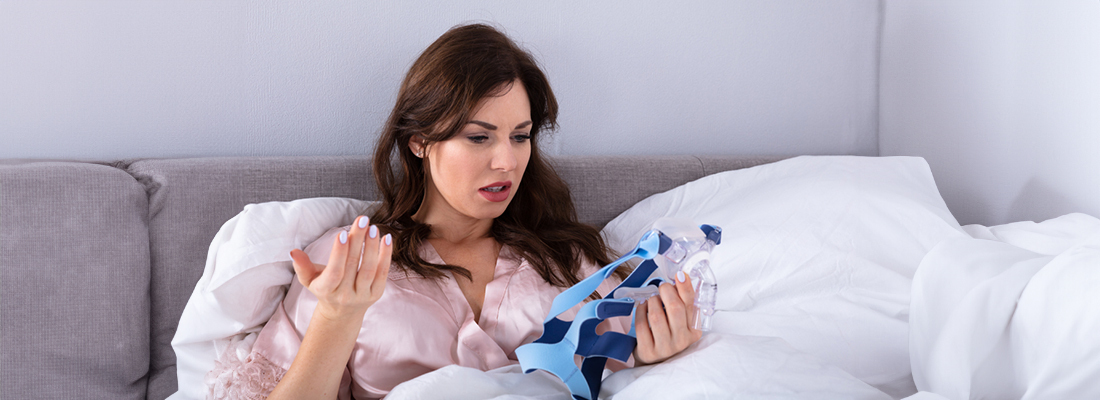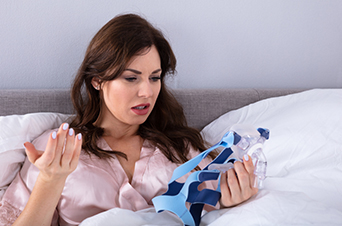
Reducing snoring with CPAP (Continuous Positive Airway Pressure) therapy has shown significant effectiveness in managing sleep-related breathing disorders, particularly obstructive sleep apnea (OSA). In this blog, we will discuss how snoring with CPAP can be managed.
Does CPAP Stop Snoring?
CPAP therapy involves a machine that delivers a continuous flow of air through a mask worn over the nose, mouth, or both during sleep. So, this airflow creates positive pressure in the airway, preventing it from collapsing or becoming blocked, which is a common cause of snoring in individuals with OSA.
Also Read: Is Snoring Genetic? Insights into Hereditary Snoring
How Snoring with CPAP Decreases?
Mechanism of Action:
CPAP works by:
- Maintaining Airway Openness: The continuous airflow keeps the throat muscles from relaxing excessively, preventing airway collapse.
- Reducing Vibrations: Hence, by stabilizing the airway, CPAP reduces the vibrations in the throat tissues that cause the characteristic sound of snoring.
Snoring with CPAP can be treated and result in a better quality of sleep.
Factors Influencing CPAP Effectiveness
There are some factors that help in decreasing snoring with CPAP.
Adherence and Proper Usage:
- Consistent Use: CPAP is most effective when used every night throughout the sleep period.
- Mask Comfort: So, proper mask fit, and comfort are necessary for adherence and optimal therapy outcomes.
Personalization and Settings:
- Pressure Settings: Individualized pressure settings based on a sleep study ensure adequate airway support without discomfort.
- Humidification: Furthermore, adjustable humidification settings can enhance comfort and compliance.
Relationship Between Snoring and Sleep Apnea
Understanding Snoring:
- Snoring is the sound produced when air flows past relaxed tissues in the throat, causing them to vibrate during sleep.
- Characteristics: typically, loud, rhythmic, and disruptive to sleep partners.
Mechanism of Snoring:
- Occurs due to partial blockage of the upper airway.
- Factors contributing to snoring: anatomical abnormalities, muscle relaxation during sleep.
Introduction to Sleep Apnea
Sleep apnea is a sleep disorder characterized by repeated pauses in breathing during sleep, known as apneas, which can last from a few seconds to several minutes and typically occur multiple times per hour. Furthermore, sleep apnea can lead to poor sleep quality and a range of health problems if left untreated.
Types of Sleep Apnea
- Obstructive Sleep Apnea (OSA): The most common type, caused by the repetitive collapse of the upper airway during sleep. This blockage restricts airflow, often resulting in loud snoring and disrupted sleep.
- Central Sleep Apnea (CSA): This type involves the brain failing to send proper signals to the muscles that control breathing. Unlike obstructive sleep apnea (OSA), central sleep apnea (CSA) is not caused by a physical blockage of the airway.
- Complex Sleep Apnea Syndrome (CompSA): This type is a combination of obstructive and central sleep apnea. So, individuals with CompSA experience symptoms of both OSA and CSA.
Common Symptoms and Diagnostic Criteria
Symptoms:
- Loud snoring: Often a hallmark of obstructive sleep apnea.
- Gasping or choking during sleep: Indicative of disrupted breathing patterns.
- Daytime sleepiness: Excessive tiredness during the day due to poor-quality sleep at night is also a symptom of sleep apnea.
- Difficulty concentrating: Moreover, impaired cognitive function can result from interrupted sleep.
Diagnosis:
- Sleep Study (Polysomnography): This diagnostic test measures various physiological parameters during sleep, including breathing patterns, oxygen levels, heart rate, and brain activity. The data collected helps in diagnosing sleep apnea and determining its severity.
So, by understanding the types, symptoms, and diagnostic methods of sleep apnea, individuals can better recognize the condition and seek appropriate medical intervention.
Linking Snoring to Sleep Apnea
Primary Snoring vs. Snoring in Sleep Apnea
Primary Snoring:
Primary snoring refers to snoring that occurs without any associated sleep-disordered breathing or significant drops in blood oxygen levels. Generally, it is considered benign and doesn’t usually lead to serious health issues. Typically, primary snoring is caused by the vibration of the soft tissues in the throat due to partial obstruction of the airway. This partial obstruction can result from factors like nasal congestion, alcohol consumption, or sleeping position. While primary snoring can be disruptive to sleep partners, it does not typically disrupt the snorer’s sleep or lead to significant daytime fatigue or other complications.
Snoring in Sleep Apnea:
In contrast, snoring associated with sleep apnea is more concerning because it often indicates the presence of periods of reduced or completely blocked airflow (apneas) during sleep. Consequently, these episodes can lead to significant drops in blood oxygen levels (oxygen desaturation), which can strain the cardiovascular system and lead to a range of health problems, including hypertension, heart disease, and stroke. Additionally, individuals with sleep apnea may experience frequent awakenings throughout the night, leading to poor sleep quality and excessive daytime sleepiness. This type of snoring is usually louder and more irregular, often punctuated by pauses in breathing and gasping or choking sounds as the person briefly awakens to resume normal breathing.
Role of Airway Obstruction in Snoring and Sleep Apnea Development
In sleep apnea, the airway collapses or becomes blocked repeatedly during sleep, causing disrupted breathing patterns. Consequently, this condition often leads to symptoms such as snoring, which is a common indicator of partial airway obstruction in affected individuals. Repeated interruptions in breathing can result in poor sleep quality and other health complications.
Health Implications of Untreated Sleep Apnea
Cardiovascular Risks Associated with Sleep Apnea:
- Increased risk of hypertension, heart disease, stroke, and arrhythmias.
- Chronic intermittent hypoxia can contribute to cardiovascular complications.
Impact on Daytime Functioning and Cognitive Health:
- Excessive daytime sleepiness impairs cognitive function, mood stability, and overall quality of life.
- Additionally, increased risk of motor vehicle accidents and occupational hazards due to impaired alertness.
Comprehending the relationship between snoring and sleep apnea is important for early detection, diagnosis, and effective management of sleep-related breathing disorders. Moreover, treatment options, like CPAP therapy, are aimed at alleviating symptoms such as decreasing snoring with CPAP.
Alternatives and Complementary Treatments
A. Oral Appliances and Mandibular Advancement Devices (MADs)
- Oral Appliances: Custom-made devices worn during sleep to reposition the jaw and tongue, thereby preventing airway obstruction.
- Mandibular Advancement Devices (MADs): Specifically designed to advance the lower jaw forward, enlarging the airway and reducing snoring and sleep apnea symptoms.
So, these devices are often recommended for individuals who prefer alternatives to CPAP or who have mild to moderate sleep apnea.
B. Surgical Options:
1. Uvulopalatopharyngoplasty (UPPP)
- Surgical procedure to remove excess tissue from the uvula, soft palate, and throat.
- Aimed at widening the airway and reducing obstruction that leads to snoring and obstructive sleep apnea.
- UPPP may be recommended when treatments like CPAP or oral appliances are ineffective or not tolerated.
2. Other Surgical Interventions
- Septoplasty: Corrects a deviated nasal septum that obstructs nasal airflow, contributing to sleep-disordered breathing.
- Maxillomandibular Advancement (MMA): Advances the upper and lower jaw to increase the size of the airway, particularly beneficial for severe cases of obstructive sleep apnea.
- Laser-Assisted Uvulopalatoplasty (LAUP): Uses lasers to remove or reshape tissue in the throat to reduce snoring and mild sleep apnea symptoms.
If CPAP therapy does not effectively reduce sleep apnea symptoms, including ongoing snoring with CPAP, the condition remains unchanged. Then, these surgical options are considered when conservative treatments have failed, or the anatomical structure of the upper airway requires treatment to alleviate sleep-disordered breathing.
Furthermore, each procedure has specific indications, benefits, and potential risks that should be discussed with a qualified healthcare provider specializing in sleep medicine or otolaryngology.
Lifestyle and Behavioral Factors
Weight Management:
- Excess weight can also contribute to airway obstruction and worsen sleep apnea.
- Thus, losing weight through diet and exercise can reduce the severity of sleep apnea and improve CPAP effectiveness.
Also Read: Home Remedies for Sleep Apnea: 7 Effective Solutions
Sleep Hygiene Practices:
- Establishing a regular sleep schedule and environment conducive to sleep promotes better sleep quality.
- Moreover, avoiding alcohol and sedatives before bedtime reduces muscle relaxation in the throat, which can exacerbate snoring and sleep apnea.
These factors can significantly enhance the effectiveness of CPAP therapy in managing sleep apnea and improving overall sleep quality. Additionally, regular follow-up with healthcare providers ensures ongoing support and adjustments to optimize treatment outcomes.
Read our blog: Can You Have Sleep Apnea Without Snoring?
Conclusion
Snoring with CPAP therapy can be significantly reduced, as the continuous positive airway pressure keeps the airway open and minimizes tissue vibrations that cause snoring. So, for individuals wondering, does CPAP stop snoring? The answer is generally yes, especially for those with obstructive sleep apnea. Furthermore, proper usage, consistent adherence, and personalized settings are crucial for maximizing CPAP’s effectiveness.

